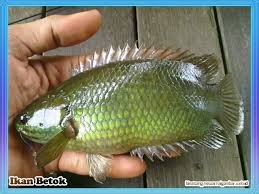
1875/5000
In the past three years, the Government of Indonesia has continued to actively discontinue illegal fishing activities conducted by fish seekers from all over the world. The activity is considered to be detrimental to Indonesia, because it decreases fish populations in the sea waters. However, such supervision has not occurred for fish in the fresh water.
Researcher of Biology Research Center of Indonesian Institute of Sciences (LIPI) Haryono explained that fish that grow in fresh water can be found in the flowing water habitat (Lotik) such as river and stagnant water (Lentik) such as lakes, reservoirs and swamps.
"The general waters of freshwater land are mainly on the islands of Kalimantan and Sumatra," he said in Jakarta last week.
Overall, Haryono said the mainland public waters in Indonesia currently reach 55 million hectares. With details, the area of river waters 11.95 million ha, lake waters / reservoirs 2.1 million ha, and swampy waters 39.4 million ha.
With such an extent, Haryono said, fish can grow well. However, there are a number of endemic fish whose populations are beginning to be threatened. Such fish, usually spread over geographic areas or limited habitats.
"In addition to endemic fish, there are also native or local fish, rare fish, endangered fish, introduced fish, and invasive fish," he said.
Given the freshwater fish grow and breed in the waters of the mainland, Haryono said, the number from time to time continues to decline. One of them, is the endemic fish that is now the number continues to decline.
In Indonesia, said Haryono, there are a total of 4782 species of native Indonesian fish are scattered in various areas of the water. Of these, freshwater fish have 1,248 species, marine fish with 3,534 species, endemic fish 130 species, introduction of 120 species, endangered 150 species, and invasive as many as 13 species.
In order for endemic fish to continue to survive and the population increases again, it is necessary to conserve the existing fish resources in the waters of the mainland. The principle of conservation, according to the lecturer of the Department of Water Resources Management Faculty of Fisheries and Marine Sciences Bogor Agricultural University, Sulistiono, has been described in Law No. 31 of 2004 on Fisheries.
"The law is regulated on the conservation of fish resources conducted through ecosystem conservation, species conservation and genetic conservation," he said.
According Sulistiono, in implementing the conservation of fish resources, the process can not be separated by the management of fish resources and the environment as a whole. In addition to the law, conservation is also regulated in more detail in Government Regulation (PP) Number 60 Year 2007 on Conservation of Fish Resources in which it is regulated on conservation management or fish habitat.
324/5000
Included in it is the development of marine conservation areas as part of ecosystem conservation, "he said.
In addition to regulating conservation, Sulistiono mentioned, in the PP also mentioned rules on sustainable use of species of fish and maintaining the genetic diversity of fish.
Sulistiono further said, many opinions from experts about the limits of conservation. However, it all depends on the time, expertise, and views of nature and dynamics.
"In the laws and regulations of Indonesia, conservation is not independent, but it is always associated with the object of legal arrangement," he explained.
With the conservation, Sulistiono said the protection, conservation and utilization of fish resources, including ecosystems, species and genetics can ensure availability, availability and sustainability while maintaining and improving the value and diversity of fish resources.
The reason why some fish need to be given conservation measures, says Sulistiono, is because they contain economic value, social value, ecological value, cultural value, religious value, aesthetic value, and the threat of extinction.
Meanwhile, the purpose of conservation of certain fish species, according to Sulistiono, are: 1) Maintaining or increasing production; 2) Natural balance; 3) genetic / species improvement; 4) explore potential benefits; 5) Tourism; 6) Education and research; 7) Aesthetics; 8) Endemic, ethnic; 9) Environmental health; and 10) Sustainability of diversity.
The decline of endemic fish in Indonesia, according to quarantine officers and freshwater fish farming of Fresh Air World Museum Taman Mini Indonesia Indah Muchamad Catim Magfur, caused by various factors. One of them, because today continues to occur illegal shipments abroad.
The illegal shipment, according to him, could happen due to weak supervision by officers in the field. To that end, the Government of Indonesia should take immediate measures to save endemic fish that are getting smaller in number from time to time.
"We should all sit together to find the best solution to keep freshwater fish populations in Indonesia. Currently, the number is decreasing, like the type of Arwana, because the supervision is still lacking, "he asserted.
In keeping with the population, according to Catim, various efforts have been taken by involving agencies such as LIPI, IPB, and freshwater fish entrepreneurs. These efforts are expected to keep the population of endemic fishes in Indonesia.
694/5000
According to Catim, efforts to save endemic fish such as Arwana, need to be done, because for some time lately in the region of Papua, arowana fish often in the loot of irresponsible people. Fish with high selling value was then sent overseas through unofficial channels.
"There must be direct action from the Government to stop illegal shipments for freshwater fish such as Arwana. If left unchecked, the population is threatened to run out, "he urged.
Currently, in Indonesia as many as 8500 species of freshwater fish live in waters of the homeland or 26 percent of the world's fish species. Of all that, there are about 440 endemic fish that must be kept preserved.